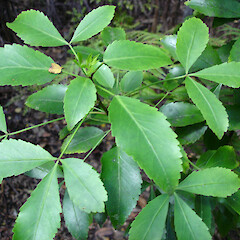Pseudopanax gilliesii
Family
Araliaceae
Flora category
Vascular – Native
Endemic taxon
Yes
Endemic genus
No
Endemic family
No
Structural class
Trees & Shrubs - Dicotyledons
Chromosome number
2n = 48
Current conservation status
The conservation status of all known New Zealand vascular plant taxa at the rank of species and below were reassessed in 2017 using the New Zealand Threat Classification System (NZTCS) – more information about this can be found on the NZTCS website. This report includes a statistical summary and brief notes on changes since 2012 and replaces all previous NZTCS lists for vascular plants.
Please note, threat classifications are often suggested by authors when publications fall between NZTCS assessment periods – an interim threat classification status has not been assessed by the NZTCS panel.
- Conservation status of New Zealand indigenous vascular plants, 2017 . 2018. Peter J. de Lange, Jeremy R. Rolfe, John W. Barkla, Shannel P. Courtney, Paul D. Champion, Leon R. Perrie, Sarah M. Beadel, Kerry A. Ford, Ilse Breitwieser, Ines Schönberger, Rowan Hindmarsh-Walls, Peter B. Heenan and Kate Ladley. Department of Conservation. Source: NZTCS and licensed by DOC for reuse under the Creative Commons Attribution 4.0 International licence.
2017 | At Risk – Naturally Uncommon | Qualifiers: DP, RR, Sp
Previous conservation statuses
2012 | At Risk – Naturally Uncommon | Qualifiers: RR, Sp
2009 | At Risk – Naturally Uncommon
2004 | Range Restricted
Brief description
Small tree with a mix of single or 3 leathery leaflets on stalks that become much longer in the lower part of the twigs.
Distribution
Endemic. Northeastern Northland
Habitat
Coastal or lowland hardwood forest and shrubland
Detailed description
Shrubby much-branched small tree to 5 m tall; branchlets slender, fleshy, brittle, light green to purpled; bark pale brown, lenticels prominent. Leaves alternate, unifoliate intermixed with trifoliate or irregularly lobed leaves; Petioles 2-8 cm long; lamina coriaceous, glossy green above, paler green below, c. 4-8 cm long, ovate, acute to acuminate, sharply serrate, on long slender petioles to 14 cm long in lower part of branchlet, trifoliate leaflets sessile or on very short petiolule; midvein prominent, lateral veins obvious. Inflorescence a terminal umbel; primary rays 3-6, c. 8 cm long, flowers racemosely arranged. Ovary 5-loculed, each containing 1 ovule (some aborted); style branches 5, connate. Fruit fleshy, subglobose, 6 x 5 mm, style branches retained on an apical disc, dark purple when ripe. Seeds 5 per fruit, narrowly ovate, 5.5-6.5 mm long.
Similar taxa
Most similar to Pseudopanax discolor from which it differs by the alternating whorls of unifoliolate to trifoliolate rather than 5-foliolate leaves, which are much thicker, more finely serrated and usually uniformly dark green to light green rather than gren to yellow green, variously spotted or stained maroon. Aside from these differences the ranges of P. gilliesii and P. discolor don’t overlap. Pseudopanax gilliesii might be confused with P. lessonii, with which it co-occurs. Pseudopanax lessonii is however a taller tree species, with much thicker 5-foliolate or trifoliate leaves with shallower toothing restricted to the distal 3/4 of the lamina.
Flower colours
Green
Threats
Probably a species naturally restricted to the northeastern non-basaltic Northland volcanics. Some habitat has been lost in the past to coastal development. Reports of this species occurring on Hauturu o Toi / Little Barrier Island are based on collections of what appears to be Pseudopanax discolor or perhaps a hybrid between that species and P. lessonii. Pseudopanax gilliesii is not found on that island/
Etymology
pseudopanax: False cure
Attribution
Description adapted from Allan (1961) and Webb and Simpson (2001).
References and further reading
Allan, H.H. 1961. Flora of NZ, Vol. I. Government Printer, Wellington
Webb, C.J. & Simpson, M.J.A. 2001. Seeds of NZ gymnosperms and dicotyledons. Manuka Press, Christchurch.
NZPCN Fact Sheet citation
Please cite as: de Lange, P.J. (Year at time of access): Pseudopanax gilliesii Fact Sheet (content continuously updated). New Zealand Plant Conservation Network. https://www.nzpcn.org.nz/flora/species/pseudopanax-gilliesii/ (Date website was queried)








